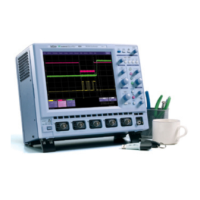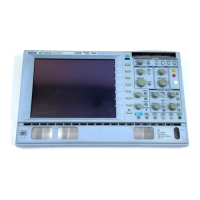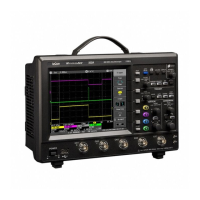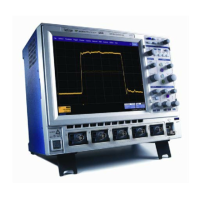WaveSurfer DSO
WS-OM-E Rev B 45
Single-shot sampling mode
Basic Capture Technique
A single-shot acquisition is a series of digitized voltage values sampled on the input signal at a
uniform rate. It is also a series of measured data values associated with a single trigger event.
The acquisition is typically stopped a defined number of samples after this event occurs: a
number determined by the selected trigger delay and measured by the timebase. The waveform's
horizontal position (and waveform display in general) is determined using the trigger event as the
definition of time zero.
You can choose either a pre- or post-trigger delay. Pre-trigger delay is the time from the left-hand
edge of the display grid forward to the trigger event, while post-trigger delay is the time back to
the event. You can sample the waveform in a range starting well before the trigger event up to the
moment the event occurs. This is 100% pre-trigger, and it allows you to see the waveform leading
up to the point at which the trigger condition was met and the trigger occurred. (The instrument
offers up to the maximum record length of points of pre-trigger information.) Post-trigger delay, on
the other hand, allows you to sample the waveform starting at the equivalent of 10,000 divisions
after the event occurred.
Because each instrument input channel has a dedicated ADC (Analog-to-Digital Converter), the
voltage on each is sampled and measured at the same instant. This allows very reliable time
measurements between the channels.
On fast timebase settings, the maximum single-shot sampling rate is used. But for slower
timebases, the sampling rate is decreased and the number of data samples maintained.
The relationship between sample rate, memory, and time can be simply defined as:
and
RIS Sampling Mode -- For Higher Sample Rates
RIS (Random Interleaved Sampling) is an acquisition technique that allows effective sampling
rates higher than the maximum single-shot sampling rate. It is used on repetitive waveforms with
a stable trigger. The maximum effective sampling rate of 50 GS/s can be achieved with RIS by
making 100 single-shot acquisitions at 500 MS/s. The bins thus acquired are positioned
approximately 20 ps apart. The process of acquiring these bins and satisfying the time constraint
is a random one. The relative time between ADC sampling instants and the event trigger provides
the necessary variation, measured by the timebase to 5 ps resolution.

